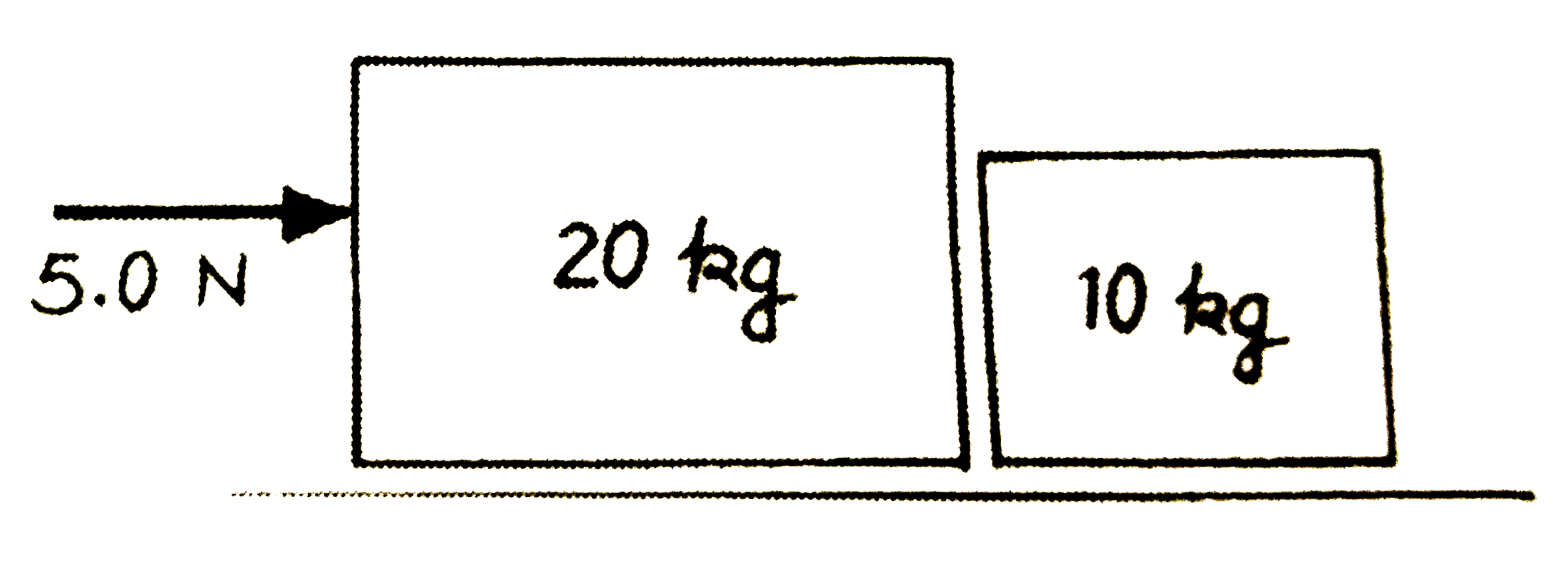Suppose the block of the previous problem is pushed down the incine witas force of 4N. How far will the block move in the first two seconds after starting from rest? The mass of the block is 4 kg.Solution in Tamil
From the free bodyi diagram 4−4−μR+4gsin300=0………i
R−4gcos300=0………ii
→R=4gcos300=0

Putting the values of R in equation i. we get
4−0.11×4gcos300+4gsin300=0
→4−4a−0.11×4×10×√32+4×10×12
→4−4a−3.81+20=0
→4−4a−318+20=0
→a≈5ms2
∴Distance,S=ut=−12at2
=0+(12)5×22
=10m Hence the bock wil move 10 m
Topper's Solved these Questions
Similar Questions
Let F,FNandf denote the magnitudes of the contact force, normal force and the friction exerted by one surface on the other kept in contact. If none of these is zero,
05:55View SolutionWater is filled in a flask up to a height of 20 cm. The bottom of the flask is circular with radius 10 cm. If the atmospheric pressure is 1.01×105 Pa, find the force exerted by the water on the bottom. Take g=10ms−2 and density of water =1000 kgm^-3.
View SolutionTwo spherical balls of mass 10 hg are placed 10 cm apart. Find gravitational force of attraction between them
01:51View SolutionA block of mass 2.0 kg is pushed down an inclined plane of inclination 370 with a force of 20N cting parallelto the incline. It is found tht the block moves on the incline with an acceleration of 10ms2. If the blcok started from rest, find the work done a. by the applied force in the first second b. by the weight of the block in the first second and c. by the frictional force acting on the block in the first second. Take g=10ms2.
02:09View SolutionA block of mass 4kg is pushed against a rough vertical wall with a force 80N is applied on the block in a direction parallel to the wall . Will the block move? If yes , what is acceleration of the block ?
05:48View SolutionA block of mass 1 kg moving with a speed of 4 ms^(-1) , collides with another block of mass 2 kg which is at rest. If the lighter block comes to rest after collision, then the speed of the heavier body is
03:47View SolutionA block of mass 1 kg moving with a speed of 4 ms^(-1) , collides with another block of mass 2 kg which is at rest. The lighter block comes to rest after collision. The loss in KE of the system is
View Solutionएक चिकनी क्षैतिज मेज पर 20 किग्रा व् 10 किग्रा की दो गुटके रखे जाते है।

(i) यदि 20 किग्रा के गुटके पर 5 न्यूटन का एक क्षैतिज बल आरोपित किया जाये तो, 20 किग्रा का गुटका 10 किग्रा के गुटके को किस बल से धकेलेगा?
(ii) यदि यही बल 10 किग्रा के गुटके पर कितना बल लगाएगा?02:51View Solutionकिसी घर्षणहीन पृष्ठ पर v चाल से चलता हुआ m द्रव्यमान का एक ब्लॉक, उसी द्रव्यमान m के विरमावस्था में स्थित एक अन्य ब्लॉक से टकराता है। टक्कर के पश्चात पहला ब्लॉक , v/3 चाल से, अपनी प्रारम्भिक गति की दिशा से θ कोण पर चलने लगता है। तो, टक्कर के पश्चात दूसरे ब्लॉक की चाल होगी :
View Solutionप्रश्न 4 में वर्णित गुटका तल पर नीचे की और 4 N बल से धकेला जाता है|विरामावस्था से गति प्राम्भ करने के बाद दो सेकंड में यह कितनी दुरी चलेगा? गुटके का द्रव्यमान 4 kg है|
02:28View SolutionA20 kg block is initally at rest. A 75 N force is required to set the block in motion. After the motion starts, a force of 60 N is required to keep the block moving with constant speed. The coefficient of static friction is
02:57View SolutionA block (A) of mass 3 kg in contact with a second block (B) of mass 2 kg rests on a frictionless horizontal surface. A horizontal force of 20 N is applied to push the block A. What is the force with which the block A pushes the block B?
View Solutionचाल 5 मी/से से गतिमान द्रव्यमान 10 किग्रा का एक गुटका विरामावस्था में रखे द्रव्यमान 20 किग्रा के एक दूसरे गुटके से टकराता है तथा चाल 2 मी/से से वापस लौट आता है | टक्कर के उपरांत दूसरे गुटके का वेग क्या होगा ?
03:47View Solutionएक द्रव्यमानहीन रस्सी द्वारा 10 किग्रा तथा 20 किग्रा के दो ब्लॉक A तथा B चित्रानुसार समायोजित है। 30 न्यूनट का एक बल ब्लॉक B पर लगाया जाता है। विरामावस्था से गति प्रारंभ करते हुए द्रव्यमान केंद्र 2 सेकण्ड में कितनी दूरी तय करेगा?
 05:49View Solution
05:49View SolutionA block A of mass 4 kg is placed on another block B of mass 5 kg, and the block B rests on a smooth horizontal table. If the minimum force that can be applied on A so that both the blocks move together is 12N, the maximum force that can be applied on B for the blocks to move together will be:
03:47View SolutionOn a frictionless surface, a block of mass M moving at a v speed collides with another block located at rest of the same mass M. The first block after the collision, v/3 Speed, from the direction of its initial speed theta Starts walking at an angle. So, after the collision the second block will move.
06:32View Solution

